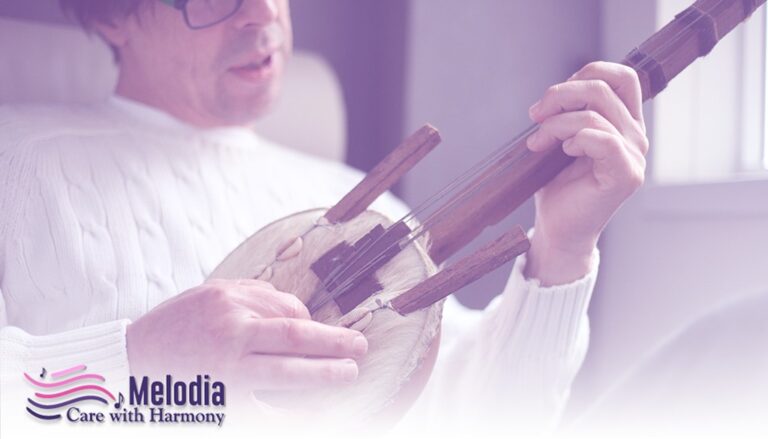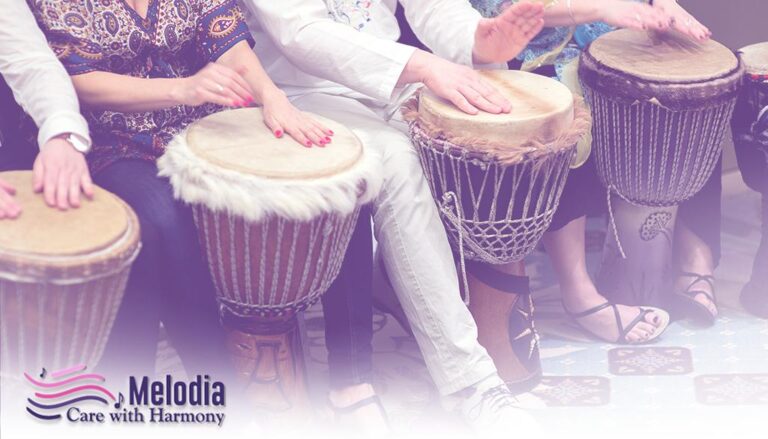Hospice Music Therapy In Antioch City, California
In Melodia Care Hospice, patients, their loved ones and the professionals who work with them frequently express a desire for sources of comfort and communication that go beyond the pharmacological, verbal and even linear communication methods. It is remarkable how well music therapy, a professional discipline that was formally established in the United States but that has existed informally since biblical times, can address many of the issues that arise for hospice patients and their families.
Music Therapy
When a credentialed professional who has completed an approved music therapy program uses music interventions to achieve individualized goals within a therapeutic relationship, this is referred to as Music Therapy.
A credentialed professional who has completed an approved music therapy program is defined as follows: “Music Therapy is the clinical and evidence-based use of music interventions to accomplish individualized goals within a therapeutic relationship by a credentialed professional.” Overall, music therapy seeks to restore, maintain or improve the health of an individual’s mental, physical, emotional or spiritual well-being.
Music therapists work with a diverse range of clinical populations across the lifespan and in a variety of settings, including psychiatric and medical settings, educational settings, clinic-based settings and private practice settings. Regardless of the situation, there are two constants:
- Always, three elements are present in music therapy: the patient/client, the music therapist and the music being used.
The music therapist comes to the patient at his or her location. Given that not everyone is affected in the same way by a particular pitch, piece of music or even a particular musical style, music therapy is not prescriptive in its nature. The design and delivery of music therapy are heavily influenced by the individual story and set of needs of each patient and it takes place within the context of the therapeutic relationship
What can Music Therapy typically help with?

Music Therapy, like any therapeutic tool, can be tailored to the needs of the individual. However, some typical goals and benefits include the following:
- Emotions should be expressed and processed in a healthy manner (Both verbally and non-verbally)
- Stress Reduction Techniques
- Analgesia (Pain Management)
- Communication should be made easier
- Making memories/reminiscing are two different things
- Creating a Lasting Impression
So, how is a session organized?

At the beginning of every session, music therapists will always meet an individual where they are, in terms of their energy and emotions. Every therapy session is tailored to the individual’s specific goals, as well as their current mood/state of mind. As a result, music-based sessions can range from guided relaxation to active participation, such as playing or singing. A personal connection to music can lead to moments of self-reflection and story-telling for everyone. There are times when no words are spoken during a session, allowing the individual to express complex thoughts and feelings nonverbally.
Additionally, music therapists in Melodia Care Hospice & Palliative Care can assist patients and their families in creating a lasting legacy.
What exactly are legacy projects?

For those who want to leave a lasting legacy, legacy building is an expressive and creative means of doing so.
- “Heart Songs” can be used as a legacy by music therapists. As part of this project, people are encouraged to record their own heartbeats and combine them with a personal favorite or meaningful song, creating a completely new cover. This is made into a CD and digital Mp3 formats so that your loved ones can listen to it whenever they want.
- Some people work with a music therapist to create CDs for their loved ones, each one chosen to represent a specific family member’s feeling.
- Some people go so far as to write and record their own music in order to leave a lasting legacy.
Legacy projects come in all shapes and sizes, just like the people we treat!
What does a Music Therapist do?

They have at least an undergraduate degree in music and must complete the American Music Therapy Association’s 1040 hours of Clinical Internship before they are eligible to sit for an independently administered Board Certification exam that is administered by the American Music Therapy Association. Expertise in music therapy requires an in-depth understanding of how music affects cognition and emotion, as well as the ability to play a variety of instruments.
As long as the goals of the project necessitate it, they can use both live and recorded music effectively. Additionally, music therapists have a great deal of expertise in non-musical areas, as well. The ability to recognize a significant reaction and skillfully explore, validate or contain the feelings expressed by the patient, family or group is essential because music has the power to recall distant memories and elicit strong feelings.
The use of music therapy in the End of life

Many hospice patients come from diverse socioeconomic, cultural, religious and family backgrounds, which makes it difficult to categorize them into one category. Each patient presents as a distinct individual, with strengths and needs that are far more complex than the sum of their diagnoses or symptoms can encompass. Using family, medical, musical and other histories, as well as information from collateral sources, the music therapist assesses the patient’s and family’s needs and ideally, in collaboration with the patient and the Melodia care hospice team, establishes treatment goals and the most effective method of achieving them.
Music therapists in Melodia Care Hospice’s care are primarily concerned with psychosocial issues, as well as spiritual and physical requirements. Even in the absence of verbal communication, music therapy can help to alleviate feelings of loneliness and provide a sense of familiarity and comfort to those who receive it. It can assist someone in maintaining a sense of control over the majority of the musical aspects of the session through decision-making. Music’s ability to elicit memories and feelings can aid in the process of reminiscing and reflecting on one’s life. Music has the ability to establish a connection with one’s past, one’s faith and one’s subconscious. It has the ability to reach a person on a deeply personal and highly individual level, while also transcending differences and awakening a sense of universality.
Some common objectives, as well as corresponding approaches/interventions, are listed as follows:
PSYCHOSOCIAL

Goal: Express and contain your grief and other emotions in a safe place.
Intervention: Composing music (to familiar or co-created melodies)
There is a possibility that this process can provide much-needed catharsis in a supportive and creative setting for patients who are able to participate. If starting from scratch is too intimidating, lyrics can be substituted into melodies that are already familiar. Additionally, this process serves as a way for a patient to affirm their sense of purpose or significance in life.
Goal: Increase the likelihood of recalling long-term memories (to connect to emotions and to experience sense of mastery)
Intervention: Songs from the patient’s adolescence or early adulthood (preferably in the patient’s native language to provide cultural reinforcement)
This type of music therapy, often accompanied by an instrumental accompaniment, is common in hospice work because music is a direct link to long-term memory. Even a brief moment of heightened lucidity brought about by music can have a profound effect on everyone involved, including the person with advanced dementia and his or her loved ones. Music’s ability to help patients regain their ability to speak and remember can be described as “magical” by family members and friends.
Goal: Strengthen ties within the family and offer moral and emotional support to those who need it.
Intervention: Singing/lyric discussion in a semi-structured group musical improvisation
Even formerly estranged family members can reunite under the guidance of a hospice. Family members can express their thoughts, feelings and wishes for the patient and each other through improvised songs and chants, possibly with untuned (rhythm) instruments.
As the patient’s illness progresses, songs and music that have special meaning to the patient’s family and can help bring the family together in a meaningful way. Additionally, this provides a way to connect with the patient that isn’t based solely on language.
SPIRITUAL

Goal: Assist patient’s faith by providing comfort, solace and support in traditional forms of worship
Intervention: Liturgical music, such as hymns, chants or the likes of it, can be sung or played.
PHYSICAL

Goal: Aid in pain perception/relaxation
Intervention: listening to calming music, whether it’s live or recorded and perhaps incorporating imagery-inspiring suggestions; matching and guiding breathing to the music.
There are a number of hypotheses as to how music therapy works but research has shown that it is effective in reducing pain perception.
How to Positively Affect a Patient with Music in 6 Other Ways

Music therapists are uniquely qualified to provide musical interventions to enhance the quality of life of hospice patients due to their diverse set of training and experience. However, the importance of music, especially for those nearing the end of their lives, is becoming increasingly apparent in our day and age. Many types of music practitioners, such as bedside singers, harpists, ipod facilitators and others who work with hospice patients, have seen an increase in recent years. Families and friends of hospice patients often discover that music can naturally comfort their loved ones as well as themselves. It is true that music can have a positive impact on a patient’s well-being in a variety of ways. These include, but are not limited to:
- Playing music requested by the patient on a smartphone or tablet with speakers. For patients, this allows them to be in control of their lives and to improve their quality of life by being positively distracted and possibly transported. You may want to consider making your own CDs or playlists to keep the hours going after your visits.
- For those who are unable to guide this process or if it is not possible for the patient to do so, it’s important that they be aware of what era and style music they’re using. For those who were born in the early 1930’s, most music after the 1950’s may not be experienced as familiar or meaningful.
- Recorded music can be used to encourage moderate physical activity to a reasonable extent (music activates motor centers and is naturally conducive to movement).
- Create a CD or playlist of your life’s memories.
- Plan the music for the memorial service.
- The Threshold Choir, a group of volunteer bedside musicians, is a good option.
Music is a cure, a tonic, orange juice for the ear – it lifts us out of depression or tears us up. Many of my neurological patients, on the other hand, benefit from music in ways that medication cannot.
You can reach us at any time of day or night by contacting us through our 24/7 online customer support chat or by calling 1-888 635-6347 (MELODI-7).
